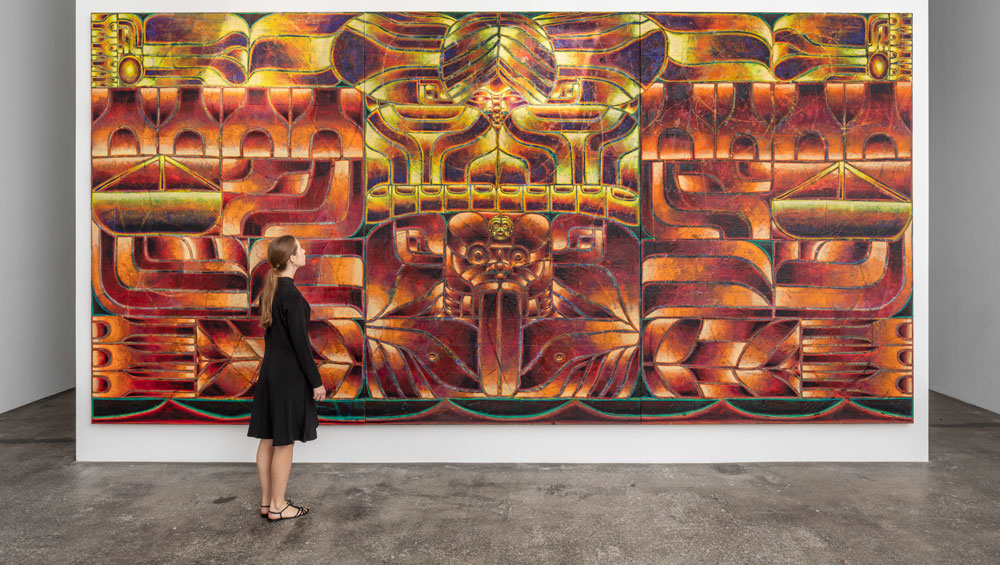
Alexander Tovborg. Mennesket og jeanne d’arc (kampen) hvem er dit sværd II [The human and Joan of Arc (the struggle) who is your sword II], 2018. Acrylic, pastel crayon, felt and holy water on wooden panel, 300 x 600 x 6 cm. Courtesy of the artist and Galleri Nicolai Wallner. Photo: Anders Sune Berg.
by KRISTIAN VISTRUP MADSEN
I first heard about Alexander Tovborg (b1983, Copenhagen) at an art fair in 2010. He is young, said the gallerist – Tovborg was not yet 30 at the time – but he is completely sincere. The line stuck in my head when later I saw his first solo exhibition, New Eternity, at Copenhagen’s Galleri Nicolai Wallner. The gallery had picked up Tovborg straight out of art school. Immediately, his practice was framed by this opposition: youth, with its restlessness and hard edges, the magnetism of its novelty, and then this particular stillness, let’s call it sincerity. Already then, his references were biblical, the works grand and unflinching. In a catalogue from 2012, Jörg Heiser described Tovborg with a line from the rapper Tyler the Creator: “I’m a fucking walking paradox – no I’m not.”
It is not surprising that the art world and its market would take to such a paradox. But the problem with sincerity is that it is, well, sincere – it’s no PR strategy. Without that useful shield of self-consciousness awarded everyone in postmodernity, Tovborg’s work is also vulnerable to controversy. At the exhibition The Symbol Has Resurrected at Blum & Poe in New York in 2017, the combination of a cross and a pentagram on the frames didn’t sit well with the blue-chip gallery’s clientele. Equally, it is not hard to imagine the identity-left shouting “appropriation” at the straight white man’s high-priced paintings. For someone as soft-spoken and sympathetic as Tovborg, it seems just another contradiction that his work could spark such an outcry.
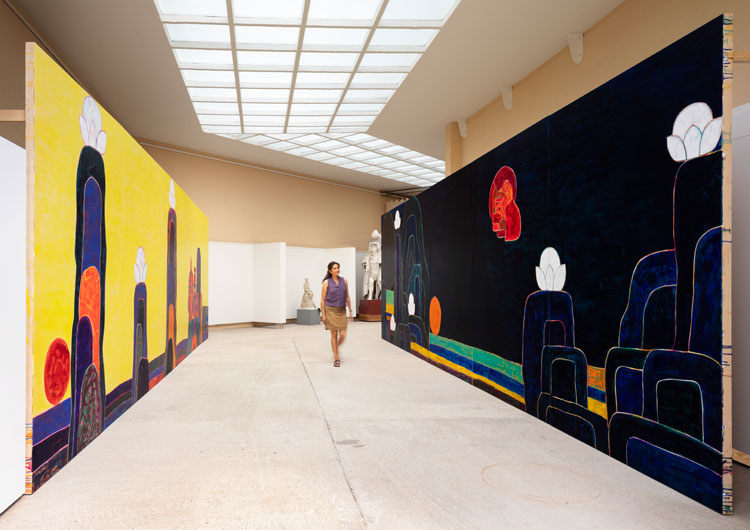
Installation view, Rudolph Tegners Museum, Dronningmølle, Denmark. Courtesy of the artist and Galleri Nicolai Wallner. Photo: Anders Sune Berg.
The steel sink in Tovborg’s Copenhagen studio has been arranged like an altar. It is full of Voodoo masks, dolls, figurines, rosaries and crosses. He picks and mixes from a highly diverse spiritual landscape that transcends the boundaries of institutions and cultures to try to get to the core of what it means to lose yourself in faith, as distinct from religion. On the wall is a small new painting ready to go with Nicolai Wallner to the Chart art fair in Copenhagen the following week. The deep blue canvas shows a mythical animal – a kind of cat, perhaps – under a dark moon, as if glowing from within.
Kristian Vistrup Madsen: You have previously said that you like your studio space to have the ambience of a grotto. I also know that you mix your pigments with holy water that you got from a grotto in Georgia. In Andreas Johnsen’s documentary about you, The Knight of Faith, which premiered earlier this year, in an especially intense scene, you visit a cave in France. What is it that attracts you about these kinds of spaces?
Alexander Tovborg: I think there’s a lot of wisdom to achieve in isolation and in absence. There’s a certain clarity to the absence of light and other people that lifts you up. You feel an immense contact to your inner self, and to a history that goes back millions of years. There’s a timelessness to the grotto that I really like. Mountains and caves are part of a system with all the other mountains and caves of the world, and it goes far beneath, into the core of the Earth, and points upwards towards a higher enlightenment.
KVM: The documentary is named after Kierkegaard’s figure The Knight of Faith, which you have dealt with a lot in your work. Prometheus is another figure that has reappeared in your work – and the cave in Georgia from where you got the holy water claims to contain the boulder to which he was chained. Both are lonesome characters who take upon themselves some sort of task. How do you see yourself in relation to them?
AT: I’ve always had the idea of being chosen, not knowing for what or by whom, but simply being pointed out to do what I do. I’m still trying to find out what that actually is, but it has something to do with bringing people together in awareness of something higher. This, specifically, relates to Kierkegaard’s Knight of Faith: in conventional thinking, when you jump, you fall back down again immediately. But I relate to the idea that if you jump, you don’t necessarily come down. Rather, from there, you jump further up, and keep on jumping into the absurdity of your cause.
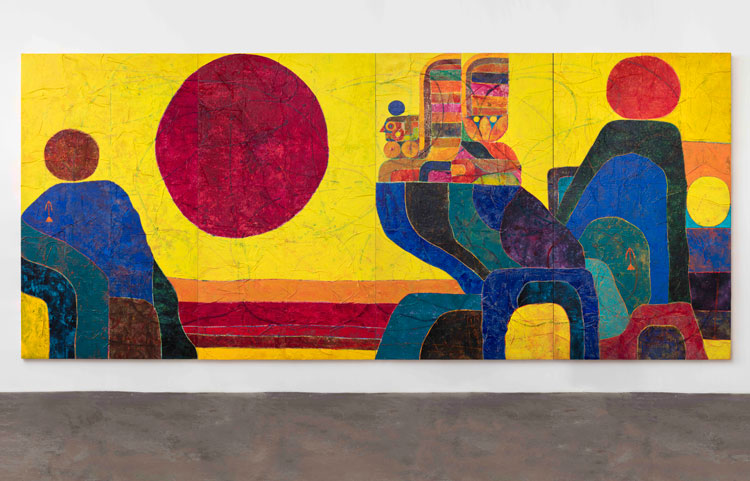
Alexander Tovborg. Sphinx and nature, 2019. Acrylic, watercolour, crayon and felt on wooden panel, 260 x 600 x 6 cm. Courtesy of the artist and Galleri Nicolai Wallner. Photo: Anders Sune Berg.
KVM: In the case of the grotto in France, you have this link to art history: the cave paintings that, in a way, began art history. Something about the myth of the artist creator relates to the myth of Prometheus and Kierkegaard’s Knight. This is a sort of outmoded idea of the tortured, lonesome and male artist genius. How do you deal with that?
AT: I don’t relate to the historical category of “the male painter” at all. I like mythological characters more. I like Joan of Arc, for instance. She struggled a lot in her life, and I don’t struggle in mine. I have a conventional practice, a good studio, I sell work. So, I don’t have the struggle until it comes to this abstract point of what art is, what we can do as artists, and what responsibility art has in creating a better future. This has nothing to do with genius. What I’m doing in my work has been seen before; it’s not the reinvention of the wheel. I’m not the kind of artist who will redefine painting. I define myself and my art more as a medium of some kind of gospel that takes place in me. So, it’s also not only about the art, but about my actions, what we do right now, encounters, conversations – it’s that wholeness that makes up the cause.
KVM: It sounds a bit like Hilma af Klint, someone who also believed she was working on behalf of something bigger than herself.
AT: I wish I could have known her. But I don’t feel as blessed, or as knowing as her. I wouldn’t dare to relate to her at all. She’s a high priestess.
KVM: But she is also someone who saw herself as outside the art world, and her work has been a long time in coming into the public eye. Yours has not: you were very quick to exhibit and to become known. It is easy for the contemporary art world to embrace your work, but it seems at the same time very particular, very adverse to what else is going on. It is the sincerity that seems to me to be what is out of time about your work. How did you come to work in this way?
AT: When I started studying at the Royal Danish Academy of Fine Arts, many people were working with fun references, formally and figuratively, and Danish black humour was everywhere in art. But, in that environment, I was struggling to be taken seriously with what I had to offer. Just before, I had done the pilgrimage from France to Santiago de Compostela on the west coast of Spain. I really enjoyed that there was a purpose to what you do, a sincere purpose. And maybe you didn’t have it to begin with, but you found it along the way in this narrative that’s very mythological. And that is how I see my practice – that’s how I started as a serious artist. I learned how to take myself and the art world seriously as a mythological journey, or cause, where everything has its meaning.
![Alexander Tovborg. Mennesket og jeanne d’arc (balancen) hvem er dit sværd I [The human and Joan of Arc (the equilibrium) who is your sword I], 2018. Acrylic, pastel crayon, felt and holy water on wooden panel
300 x 600 x 6 cm. Courtesy of the artist and Galleri Nicolai Wallner. Photo: Anders Sune Berg.](/images/articles/t/086-tovborg-alexander-2019/balancen_3_300dpi.jpg)
Alexander Tovborg. Mennesket og jeanne d’arc (balancen) hvem er dit sværd I [The human and Joan of Arc (the equilibrium) who is your sword I], 2018. Acrylic, pastel crayon, felt and holy water on wooden panel
300 x 600 x 6 cm. Courtesy of the artist and Galleri Nicolai Wallner. Photo: Anders Sune Berg.
It’s like a tea ceremony: every part of the process is loaded with meaning. I was also once an apprentice with a tea master in Kyoto. Living with him was another very educational experience. Every step of the process towards making a cup of tea was taken seriously. It starts in the morning when you pick a flower from nature and write a poem about it. And when people come in for the tea ceremony, that’s all there is – a poem and a flower – and you sit and reflect on them. It also has to do with the size of the space: how do you sit, where do you sit, how do you boil the water, is it an open fire or a gas fire, what do you boil the water in, and how do you hold the cup so that it knows that the water is going to be hot? Giving life and meaning to everything creates a magical existence around you. Everything is alive and here for a reason.
KVM: When you paint, everything has also been considered in a similar way: how you approach the canvas, and the water you use to mix the pigments with.
AT: This is also because I’m very bad at reading. But I can feel and, by physical presence, I can understand things better than by reading about them in books. For instance, when I wanted to make a painting of St Francis of Assisi preaching to the birds, I had to go there and preach to the birds in a city like he did, in order to overcome the challenges of, say, choosing a colour palette, and sense the proportions of the piazza in relation to the birds. How do you preach to the birds? You cannot read it, you have to do it. I feel the same with religion, spirituality and mythology. There are a lot of things to read, but there’s also a lot of distance. You can read about Odysseus, but how about actually sailing where he sailed, and reactivating the mythology.
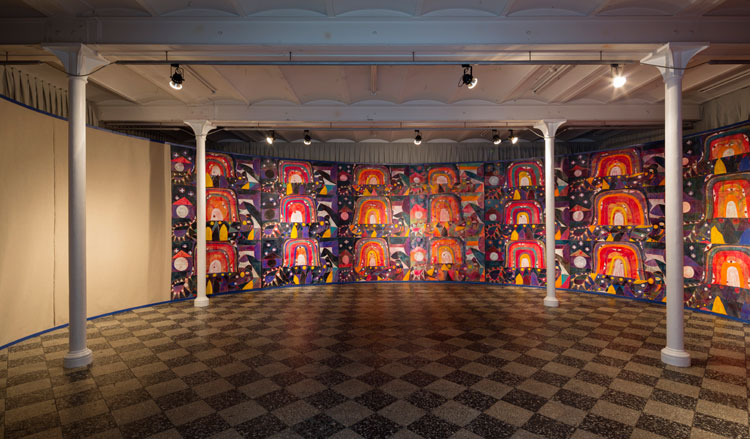
Alexander Tovborg. Bocca Baciata, 2014. Installation view, Overgaden Institute of Contemporary Art, Copenhagen, Denmark. Courtesy of the artist and Galleri Nicolai Wallner. Photo: Anders Sune Berg.
KVM: St Francis of Assisi is an old master’s topic, a very grand subject to approach. I think people understand contemporary art through an expectation of its self-consciousness that is linked to the potential for irony. Is there irony, or is it pure sincerity? There is sometimes a performative element to your exhibitions. Is that what bridges this expectation of self-consciousness?
AT: One of the reactions to my performances is laughter. I don’t know if it’s laughter as in “that’s funny”, or if it is uncertainty. But there’s definitely laughter. I just take holy water and baptise everyone. They have the opportunity to say no but, if they’re smiling and happy, I just keep on baptising them until I see some kind of reaction from them that’s not irony. Nothing wrong with irony or humour, but I don’t relate to humour. In my personal life, I hope I’m funny, but it’s not something I’m working with or towards with my art. Maybe I’m even working against it.
KVM: Sincerity or faith must be one of the most difficult or taboo subjects at the moment. I think people are not prepared to go into an exhibition space where someone is unironically baptising people.
AT: I’m becoming more aware of how distant people feel to the idea of faith. A lot people think it has to do with religious institutions. For instance, I use the cross a lot because I was born in Denmark and raised as a Protestant, and, for me, it’s been the most clear and relatable symbol. It’s not a matter of a certain kind of Protestantism, but about generating childhood memories and family history through this symbol. People deal with faith by trying to get out of it, but always the idea of institutionalised faith. I am trying to go beyond the institutions. I want to talk about them, but I never want to engage directly with institutions without having a dialogue about where that institution is today, and what the purpose would be of creating art within that institution. Institutions survive by claiming timelessness and capitalising on faith, and I’m on a crusade against this idea. I don’t think it should be like that.
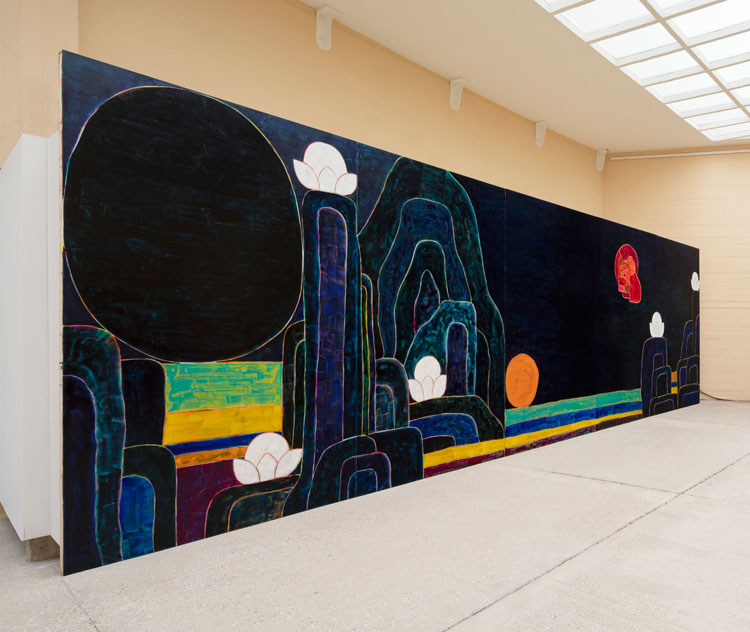
Alexander Tovborg. Guddommen og dens skabere I (Divinity and its creators I), 2019. Acrylic and pastel on wooden panel, 300 x 1,000 x 6 cm. Installation view, Rudolph Tegners Museum, Dronningmølle, Denmark. Courtesy of the artist and Galleri Nicolai Wallner. Photo: Anders Sune Berg.
KVM: So when you baptise people at an exhibition, it is also about taking a certain authority upon yourself, or undermining that authority, and saying: “Anyone could do this.” I know you have also made an altarpiece for a new church in Denmark. How did you engage with the institution in that instance?
AT: That was a very interesting experiment. It was a long time since a new church had been built in Denmark; rather, churches tend to be closing. The architects Rørbæk and Møller made a structure with no tower and no roof. Only the doors have angles; all other parts of the buildings are curved. I was interested in their idea of creating a space that is new in the history of Danish church architecture. Normally, everything is proportional to a divine symmetry where you have a long walk towards the altar. But in this church, you have to walk, not straight, but to the right – everything is a bit off. Henrik Plenge Jakobsen did the floor, Lea Porsager did the baptismal font, and I did the altarpiece. There were a lot of new ways of thinking that I’m very proud to have been a part of. You can’t change things in a day, but you can be part of making small changes slowly.
KVM: It seems your position oscillates between being a kind of eccentric outsider who has very different ideas from the institution, and then someone working, as you say, in a very conventional medium and with a pretty familiar formal language. On your shelves are books about artists such as Gustave Moreau and Ernst Fuchs, and you have just completed a big work for the Rudolph Tegners Museum in the Danish town of Dronningmølle. Moreau, Fuchs and Tegner are artists who were pretty well known in their own time, but then fell outside art history, and today seem kitsch and crazy. Why are you interested in this type of artist’s position?
AT: My fascination with Tegner started long ago. I’m not very tall, and didn’t grow for a couple of years when I was a child, so when I was younger I was really very little. You’ve been to the museum – the proportions are magnificent, the sculptures are not to human scale. And, because I was so little, I was dazzled by this imposing way of manifesting yourself. Tegner devoted his life to making these huge sculptures, and he did everything he could to realise them. He used his wife’s money, and her father’s money, to build this museum. He had this idea, I think, that the more important the subject of the work, the bigger it had to be in size. There’s this one piece called St Peter with the Key that I’ve sometimes referred to in my work. It’s a huge body builder, basically, and he’s standing there, as if flexing his muscles in front of the mirror at the gym, looking like Arnold Schwarzenegger on too many steroids. Every muscle is about to explode from lifting the weight of this huge key, which is the key to paradise. Tegner must have thought that to be able to lift the key to paradise, you have to be huge and pumped. It couldn’t have been a small or fragile girl who has the wisdom, it had to be a man. And he saw himself in this piece: he portrays St Peter with his own face.
KM: He is crazy!
AT: He’s delusional! I really thought his way of thinking was extreme. He saw himself as the gatekeeper of some kind of art paradise, where, on judgment day, perhaps because he was an outsider, he could look at all the people who didn’t like his work and decide who could join him in heaven. Whether or not I like his personality, his oeuvre has certainly made a mark on me in terms of thinking about what is possible. For the exhibition at Rudolph Tegners Museum, which is part of the North Coast Triennial, I decided to use two panels, equally huge in size, 10 x 3 metres. They had to be this big to work as a kind of scenographic background to his sculptures. It’s as if his sculptures become the characters in my painting. But, also, the viewer is automatically captured in this mythological timeline. It’s big enough that you feel like you can walk into the landscape. In that way, it’s inevitable that you’re part of the work.
![Alexander Tovborg. Guddommen og dens skabere II [Divinity and its creators II], 2019. Acrylic and pastel on wooden panel, 300 x 1,000 x 6 cm. Installation view, Rudolph Tegners Museum, Dronningmølle, Denmark. Courtesy of the artist and Galleri Nicolai Wallner. Photo: Anders Sune Berg.](/images/articles/t/086-tovborg-alexander-2019/_O5A9960.jpg)
Alexander Tovborg. Guddommen og dens skabere II [Divinity and its creators II], 2019. Acrylic and pastel on wooden panel, 300 x 1,000 x 6 cm. Installation view, Rudolph Tegners Museum, Dronningmølle, Denmark. Courtesy of the artist and Galleri Nicolai Wallner. Photo: Anders Sune Berg.
KVM: Tegner’s work, as you say, is so weird – sometimes horrific and grotesque. By comparison, your work tends to be more mannered and poetic. Is it right to say that you have based this work on a drawing of his?
AT: I worked from a sketch that he worked on for 30 years. He made a piece called Guddommen og dens Skabere [Divinity and its creators], a sculpture that he showed in the salon in France around 1900. I think he got a medal for it, too. From the drawings and diaries, you can see that he had bigger plans for this sculpture. There was a whole gallery of characters that were part of the drawing: the man as Christ, the woman as Eros, and the God as a kind of tower construction. In front of them, there’s a trinity, there’s death, there’s a man working on an anvil, people having a lot of sex, sort of an orgy, people eating and being sick. With these two works, I wanted to open up the landscape and take out the characters. I took Eros and Christ, trying not to put them in a box of man and woman. I wanted to have them rather as symbols, free of gender, more like creatures, a swan and an anvil. With our western background, we think swan equals woman and anvil equals man, but I like trying to break down these symbols.
KM: Although Tegner is someone who probably had very strong and highly conventional ideas about what the myths represented, there is a lot of potential for this in his work. Because it is so camp, so over the top, there is an element of performativity that leaves gaps to deconstruct all these figures and reinvent them. Your figures are rarely recognisable – it is more that they always get at some recognisable feeling. There is something very mysterious about them.
AT: I like the mystique. I’d like to bring back mystique in art. I think it’s been out for too long. I don’t agree that art should be explained – not too much, at least. How you look at art is a personal matter. It’s something you deal with yourself. It’s a huge privilege as an artist to make work for one person at a time, and to believe that just one person looking fulfils the mission of your work. I wish I could take art back to where it was something that you find in a grotto. Whether years later, or minutes after, it doesn’t matter. But it must be something that you find, not something that you’re given and have to take. Art should be something you find yourself.